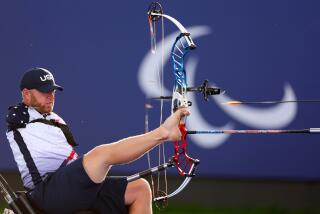This World of Tennis Is on Wheels
- Share via
So John McEnroe has won four U.S. Opens, three Wimbledons and assorted other tournaments in his grand, fine career.
Big deal.
I mean, he’s got two legs and two arms and all his eyes and ears, hasn’t he? What’s the problem?
What if he had to play sitting down?
Brad Parks has never played tennis any other way.
Boris Becker doesn’t like to play on clay. Slows down his booming game.
What if it slowed down his wheelchair?
Ten years ago, Bradley Alan Parks was your typical California teen-ager. Blond and bronzed, brought up on the ocean, all he wanted out of life was the perfect wave, 12 inches of new powder and maybe Led Zeppelin or Fleetwood Mac on the stereo. Life was a beach, all right. Or maybe a slope.
He had just turned 18 that day when he entered the freestyle skiing competition at Park City, Utah. Trick skiing was a blast. He had this stunt where he went off the ramp and up and over in a spectacular back flip. Only this time, he went around once too many times. Instead of landing on his skis, he landed on his back.
In an instant, he turned from superb young athlete into a paraplegic. He went from “California Dreamin’ ” to “Where’s the rest of me?”
“It was a funny thing but I knew it right away,” he says. “I had seen this movie, ‘The Other Side of the Mountain,’ the Jill Kinmont story, and I knew what had happened to her had happened to me. I was really afraid to reach down and touch my legs because I knew I wouldn’t be able to feel it.”
One of nature’s little ironies is that catastrophic accidents so often occur to the fittest, most active among us. The people least able to countenance life in a sedentary, trapped position frequently find themselves having to. The risk takers suddenly can’t take any.
When life deals you a busted straight like that, you can do one of two things. You can go sit in a corner and become crabbed and cynical and make yourself and everyone around you miserable. Or you can play the cards you’re dealt and keep smelling the roses.
Brad Parks’ first question was, “Will I be able to ski again?”
The answer to that one was easy: How can you ski when you can’t walk?
Being an athlete is a mind set. Brad Parks got off surfboards and skis and onto wheels but he still wanted to go around beating somebody at his own game.
At UC Santa Barbara, he began to experiment with his wheelchair, competing with the campus’ bicycles in races. He soon graduated to wheelchair track meets and began setting world records at distances from 100 meters to 10 kilometers.
He tried wheelchair basketball and then, one day, he saw a couple of wheelchair athletes batting a tennis ball across a net. A light flashed.
Tennis is a position sport. There is the power game and then there is the game where you figure out where the ball is going and get there before it.
Parks quickly knew that this was the kind of game he had to play. But first, the old standard hospital wheelchairs, which had not changed much since President Roosevelt governed from one, had to be made more maneuverable for backcourt play. Everest & Jennings, the world’s largest manufacturer of wheelchairs, delivered a 19-pound machine from which Parks could get tennis balls back the way Bitsy Grant or Chris Evert could.
Once an athlete finds a game, he wants a league. The National Foundation of Wheelchair Tennis was founded by Brad, 100 years after Wimbledon, in January 1980.
You won’t see Ivan Lendl, McEnroe, Becker or Martina Navratilova at the eighth annual Everest & Jennings U.S. Wheelchair Tennis Championships at the Racquet Club in Irvine this week.
You won’t see a lot of people screaming at umpires--in most of the matches, there aren’t any.
But you’ll see a lot of athletes from all over the world who, if it weren’t for a turn in the road, an S-curve on a rainy night, a rock in the snow, a blowout, a war or just a bad break, could be in a real open tennis tournament. One of them, Rick Slaughtert, was tennis champion of Tennessee before he was disabled.
You won’t see the 140-m.p.h. serves--the ball is permitted to bounce twice--but you’ll still see a lot of people who could beat you sitting down.
Brad Parks is as glowing with health as Pat Cash or any Swedish Davis Cup star. Head, heart and lungs are perfect, temperature normal, blood pressure in limits, pulse steady. It’s just his spinal column, the switchboard of the body, that is disconnected.
Anybody can pounce on a forehand down the line if his legs work. It’s when you have to ship the racket and spin two wheels, then grab the racket and swing, that it becomes a test of determination.
The wheelchair players have determination in abundance. They’re a lot more inspiration to us than any set of Wimbledon quarterfinalists I’ve ever seen. McEnroe would really have something to complain about if he had to play the way these people do.
They not only don’t complain, but Brad Parks says, sincerely, “It’s not the worst thing in the world. People think being in a wheelchair is the worst thing in the world, but I find myself very happy. I think anybody who is able to go out and play three sets of tennis is very lucky.”
It’s that stand-up tennis that makes you feel sorry for yourself.
More to Read
Go beyond the scoreboard
Get the latest on L.A.'s teams in the daily Sports Report newsletter.
You may occasionally receive promotional content from the Los Angeles Times.










